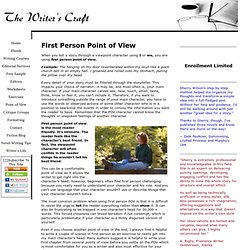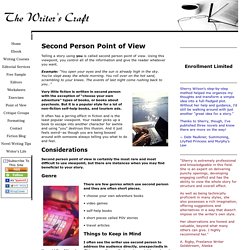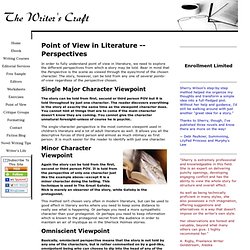

First Person Point of View — The Writer’s Craft. When you tell a story through a viewpoint character using I or we, you are using first person point of view.

Example: The banging on my door reverberated within my skull like a giant church bell in an empty hall. I groaned and rolled onto my stomach, pulling the pillow over my head. Every detail of your story must be filtered through the storyteller. This impacts your choice of narrator—it may be, and most often is, your main character. If your main character cannot see, hear, touch, smell, taste, think, know or feel it, you can’t include it. First person point of view is the most reader friendly. This can be a comfortable point of view as it allows the writer to get right into the character’s head; however, beginners often find first person challenging because you really need to understand your character and his role. The most common problem when using first person POV is that it is difficult to resist the urge to tell the reader everything rather than show it.
Considerations: Second Person Point of View — The Writer’s Craft. Enrollment Limited Sherry Wilson's step-by-step method helped me organize my thoughts and transform a simple idea into a full-fledged plot.

Without her help and guidance, I'd still be walking around with just another "great idea for a story. " Thanks to Sherry, though, I've published three novels and know there are more on the way! ~ Debi Faulkner, Summoning, LilyPad Princess and Murphy's Law "Sherry is extremely professional and knowledgeable in this field. As well as being technically proficient in many styles, she also possesses a rich imagination, offering suggestions and alternatives in a way that doesn't impose on the writer's own style.
Her observations are honest and valuable, beyond what many others can give. A. "WOW! I really appreciate the work you've done so far. --Lena Jones. Third Person Point of View — The Writer’s Craft. Enrollment Limited Sherry Wilson's step-by-step method helped me organize my thoughts and transform a simple idea into a full-fledged plot.

Without her help and guidance, I'd still be walking around with just another "great idea for a story. " Thanks to Sherry, though, I've published three novels and know there are more on the way! ~ Debi Faulkner, Summoning, LilyPad Princess and Murphy's Law "Sherry is extremely professional and knowledgeable in this field. As well as being technically proficient in many styles, she also possesses a rich imagination, offering suggestions and alternatives in a way that doesn't impose on the writer's own style. Her observations are honest and valuable, beyond what many others can give. A. "WOW! I really appreciate the work you've done so far. --Lena Jones "Sherry Wilson has a deep understanding of the craft of writing and a natural gift for the art of writing.
Being an editor myself, there are not too many people I would trust with my own work. Omniscient Person Point of View — The Writer’s Craft. Basically, omniscient point of view means that the story is told from an all-seeing God-like, omnipotent viewpoint.

You would use third person pronouns in the writing, but you can choose to dip into the head of any of the characters and reveal things that have occurred in the past or will happen in the future. This was once a very popular method of storytelling. It is less so now, especially in the North American market. Still there are some cases where this can add extra dimension to your writing when done well.
Joseph Conrad was a master of omniscient viewpoint. The trouble is that each character must have a distinctive voice so that the reader is never at a loss as to whose head he is in at the moment. Limited Omniscient Viewpoint As I mentioned, true omniscient viewpoint is very rare, but limited omniscient is often useful for modern writers. Considerations True omniscient viewpoint can be difficult for your reader to follow.
Perspectives — The Writer’s Craft. In order to fully understand point of view in literature, we need to explore the different perspectives from which a story may be told.

Bear in mind that the Perspective is the scene as viewed through the eyes/mind of the chosen character. The story, however, can be told from any one of several points-of-view regardless of the perspective chosen. Single Major Character Viewpoint The story can be told from first, second or third person POV but it is told throughout by just one character. The reader discovers everything in the story at exactly the same time as the viewpoint character does. The single-character perspective is the most common viewpoint used in children’s literature and a lot of adult literature as well. Minor Character Viewpoint Again the story can be told from the first, second or third person POV.
This method isn’t chosen very often in modern literature, but can be used to good effect in literary works where you need to keep some distance to really see what is happening.